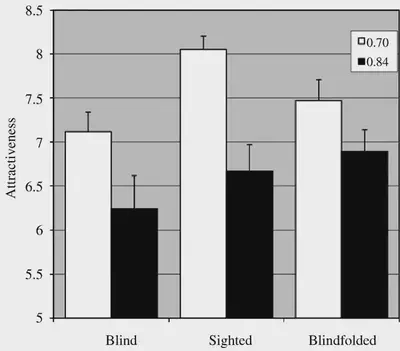Blind men prefer a low waist-to-hip ratio
Authors: Johan C. KARREMANS, Willem E. FRANKENHUIS, Sander ARONS
Presenter: CUI Tianxiang
2022.09.06
Contents
- Introduction
- Methods
- Results
- Discussion
- Limitations
Introduction
- Males prefer females with a low waist-to-hip ratio (WHR)
- An indication of health and fertility
- A biological characteristic
- A psychological mechanism of responding to exaggerated features
Introduction
- A cross-cultural preference for low WHR
- In different populations: Caucasians, Hispanics, Indonesians, and Kenyans
- WHR preferences differ between cultures
- Local ecology (e.g., the amount of food)
- Cultural transmission
Introduction
- The role of visual input in the preference for low WHR
- Visual learning: the feature of low WHR
- Children’s observation
- The influence of Western media
Introduction
- What about congenitally blind men?
- Lack the preference for low WHR (no visual experience)
- Have a less pronounced preference for low WHR than sighted men
- Exhibit a preference for low WHR as strong as their sighted counterparts
Methods
- Participants and design
- 19 congenitally blind men (27-72 years old, Mage = 46.5, SD = 14.43)
- 2 were excluded from data analysis
- 38 sighted men were randomly assigned
- 19 in the sighted condition (23-69 years old, Mage = 45.4, SD = 14.90)
- 19 in the blindfolded condition (25-68 years old, Mage = 44.5, SD = 14.75)
- 19 congenitally blind men (27-72 years old, Mage = 46.5, SD = 14.43)
Methods
- Procedure and materials
- The experiment was conducted inside a van
- Two female mannequin dolls
- Identical in dressing, differ in WHR (0.70 and 0.84)
- Similar volumes
- BMI is a irrelavant variable
Methods
- Procedure and materials
- Why 0.70 and 0.84 for WHRs?
- In Western populations, attractiveness ratings generally peak at around 0.70
- Average female WHRs in Western populations range from 0.76 up to 0.84
- Pilot study: normal range
- Why 0.70 and 0.84 for WHRs?
Methods
- Procedure and materials
- The blind participants inspected the body and rated the attractiveness
- The grade ranges from 1 to 10, with 10 representing very attractive and 1 very unattractive
- Participants in the sighted condition
- Looked at the bodies and rate their attractiveness
- The blind participants inspected the body and rated the attractiveness
Methods
- Procedure and materials
- Participants in the blindfolded condition
- The same procedure as the blind participants
- Participants in the blindfolded condition
Results
- ANOVA
- The within-participants variable: the ratings for the two bodies with the different WHRs (0.70 and 0.84)
- Between-participants variables: group (blind, sighted, and blindfolded) and order of rating (first 0.70 versus first 0.84)
Results
- ANOVA
- A significant main effect of WHR (participants overall preferred a lower WHR)
- No other significant effects (main effects of group, interactions of WHR with group, WHR with order, and the The three-way interaction between WHR, order, and group)
Results
Paired t tests within each group: significant effects of WHR
- Blind group, d = 0.68
- Sighted group, d = 1.33
- Blindfolded group, d = 0.54
Results

Discussion
- Visual input is not necessary for low WHR preferences
- Visual input may have strengthened this preference among sighted men
- Why do blind men develop a preference for low WHRs?
- Verbal information
- Generic psychological mechanisms / Prototypical stimuli
- Intrinsic factors
Limitations
- Not feasible to examine preferences of blind and sighted men for a larger number of WHRs
- Did not systematically manipulate some variables
- Hip size, waist size, and weight
Thank you for your listening!
Blind men prefer a low waist-to-hip ratio Authors : Johan C. KARREMANS, Willem E. FRANKENHUIS, Sander ARONS Presenter : CUI Tianxiang 2022.09.06